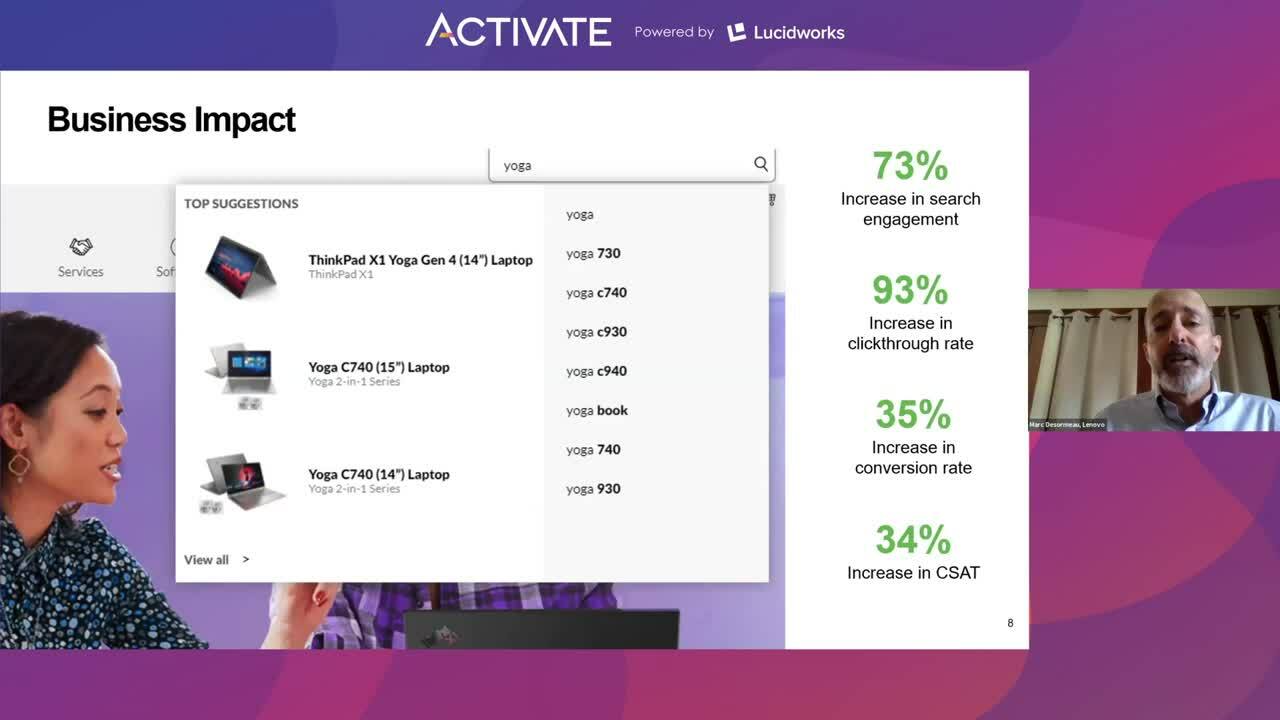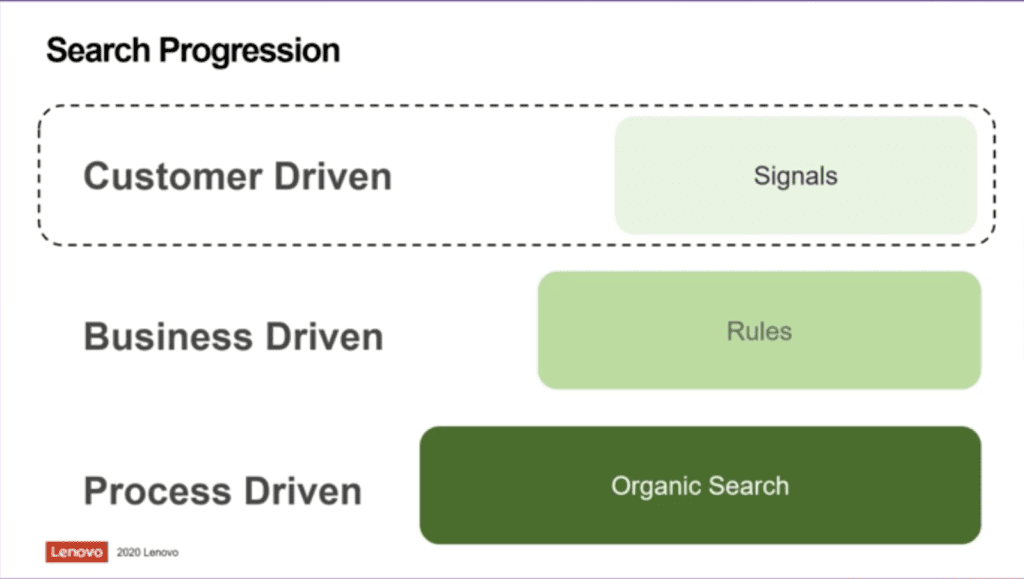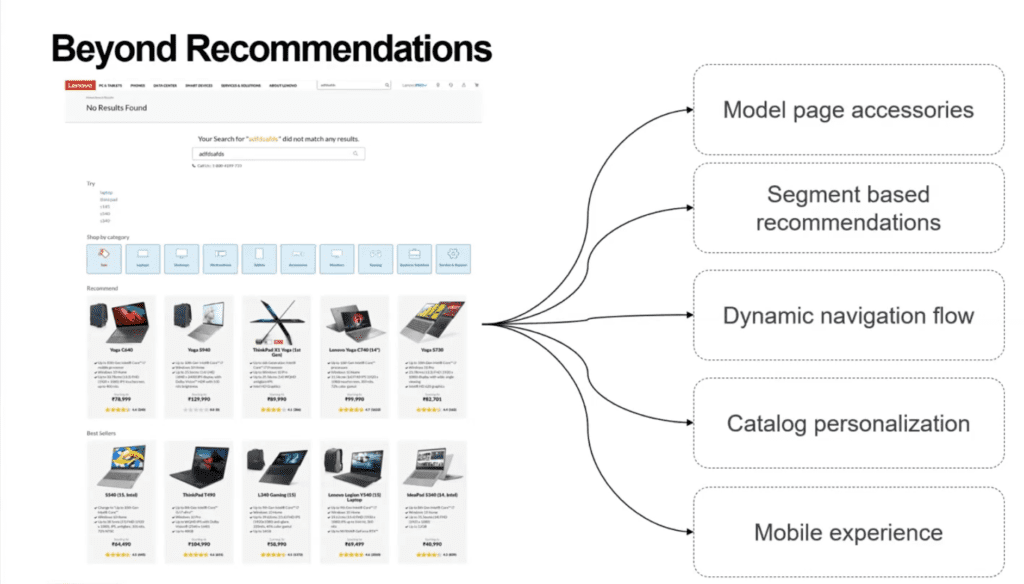Lenovo’s Climb Up The Search Ladder
Three years ago, top PC market share holder Lenovo set out on a journey to transform their search. At Activate, Lenovo’s Product Owner for Site Search and Product Data Optimization, Marc Desormeau, shared the steps Lenovo took to ultimately improve clickthrough rate on Lenovo.com by 93% and increase customer satisfaction by 34%.
Watch Marc’s talk here:

Lenovo’s vision of search existed beyond the bounds of a small search box. Recognizing the valuable information that customers put into the search bar, Lenovo wanted to capture and aggregate this data to produce actionable insights into its customer’s behavior and desires. With these signals, Lenovo would be better equipped to give customers the experience and products they wanted.
After a lengthy vetting process, Lucidworks Fusion was chosen as the vehicle that could bring Lenovo to their desired destination. Like most other search implementations, Lenovo began with simple, organic search that provided access to content aggregated from various repositories, owned by a few different creative units.
Desormeau noted that, in this initial phase, “the success of the search results depend largely on the quality of the content so this is really a process-driven search experience.”
Rev Up Your [Search] Engines

To bring search results closer to customer intent, rules were applied within Fusion. Using rules, internal experts made educated decisions about what results customers would respond to based on their queries. While this business-driven approach improves relevancy over simple keyword matching, the benefit is limited by the knowledge of those internal experts, and is often driven more by the business goals of the experts rather than the true desires of customers.
Finally, Lenovo implemented Fusion signals, giving customers the power to drive their own search experience. Signals feed into machine learning algorithms which fine-tune search results based on the user’s behavior. Lenovo no longer had to make educated guesses at what its customers were looking for. Human intervention was no longer required and pivots in the market (think COVID-19) were factored into the search experience in real-time. Relevancy improved by 55% within just a few months of launching signals.
Driving With Signals
As the application of signals matured at Lenovo, what began with grouping and serving customer segmentation layers (geography, store information, etc) gave rise to personalized mechanisms that guided customers down a path that required little human intervention to the place where customer goals and Lenovo’s goals intersected.
Connecting signal data with typeahead and recommendations removed roadblocks. When customers were stumped, these mechanisms helped guide them to the next best step.
“This is really a tipping point for the business in terms of starting to recognize what we as a search team have been saying all along, and really, the promise of value from Fusion,” shared Desormeau. “For us, it was starting to get beyond the search box, so starting to say, ‘well, look, we can not only understand what customers want, but we can start providing results, improving results in a way that is better than human intervention.’”

With signals implemented for a year, Lenovo has seen marked results. A 73% increase in search engagement, 93% increase in clickthrough rate, and 35% conversion rate has led to a 34% increase in customer satisfaction.
In parallel, customers who interact with search are now spending more money on Lenovo.com than those who only use browse. Search revenue growth has outpaced browse growth by 23%, an indication that search is more rapidly and more successfully providing the results that allow customers to achieve their goals.
Rapid Pivots in Response to the Pandemic
In the times of coronavirus, there is an added benefit to relying on machine learning algorithms over the always-slightly-delayed human process of gathering data, studying and extracting behavior patterns, and then applying search rules.
COVID-19 has caused atypical consumer behavior: individuals are making what are ordinarily business purchases to supply their work-from-home office, certain products are in high demand while others sit on the shelf. To complicate things further, these behavior changes are not consistent across the globe, or even across one country. Lenovo has seen purchase patterns vary in micro-regions, and the patterns shift rapidly in response to the new finding or news story of the hour.
Using signals fed into machine learning allows Lenovo to make quick pivots in what and how the customer is served. “Traditional business processes are struggling to keep up with the rate of change of business at all levels. What we found is, with the application of signals, we’ve been able to adapt and modify the experience based on very local trends.”
Implementing customer-driven search with signals allows Lenovo to support the critical and changing needs of their customers.
Outside of the Box
Having reached the top of the search ladder, Lenovo’s Search Team stepped out onto the diving board. Looking back at its initial goal of search not bound by a box, and choosing Fusion as an insights engine rather than a simple search tool, it began to design the ways Fusion could be leveraged even further.
“The goal was always to start joining data in creative and new ways. While customers don’t realize it’s Fusion and the search engine driving these insights, driving these recommendations, and this user experience, it’s really the same technology, the same business process, and the same machine learning and algorithms and tools that have been put in place, and we’re now starting to scale that beyond search.”

Lenovo plans to use Fusion for model page accessories, segment based recommendations, dynamic navigation flows, catalog personalization, and to drive a customized mobile experience. With Fusion in its toolbox, the Search Team can rely on machine learning to provide customers with the products and the experience that best serve them without having to recreate and recode for each different device, geography, or user segment.
“Fusion gives us a vehicle that provides us quantifiable ways to improve our connection with customers by really understanding the different ways that they engage with the site and being present in a way that’s relevant to the customer where they need us and when they need us,“ said Desormeau.
Read more about Lenovo’s learnings and wins on their journey to transform search.